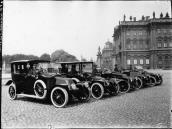|
|
Entries
/
Horse-car
Horse-car
Categories /
City Services/Transportation/Municipal Transportation
HORSE-CAR (horse-railway; horse-tram), a railway type of omnibus. In the second half of the 19th - early 20th century horse-cars were the most available passenger public transport means. Horse-cars consisted of a wagon (streetcar) of about 8 m in length with two harnessed horses, hauling it along rails. The car had an upper passenger deck ("imperial"), where the fare was lower. Horse-cars were serviced by a coachman and a fare collector. A private Horse railway company (with the administration unit situated at 3 Troitskaya Street, presently Rubinsteina Street) was founded in 1862, and until 1917 horse-car service remained a private business. On 27 August 1863, the company launched the first route from Znamenskaya Square along Nevsky Prospect to the Spit of Vasilievsky Island. By the year 1865 the horse-trams carried two million passengers. Joint-stock horse-railway society was established in 1876, with the Administration Headquarters located at 35 Liteiny Avenue, which supervised six horse-tram depots (Rozhdestvensky in the vicinity of the present 1st Sovetskaya Street, Narvsky around Traktornaya Street, Vyborgsky at the corner of 23/19 Lesnoy Avenue and others). In 1878 the Nevsky Suburban Horse-Railwaу Society was established with headquarters at 160 Nevsky Prospect, servicing the areas around Shlisselburg Road from Nikolaevsky Railway Station to Murzinka Village, with a depot in Alexandrovskoe Village. By 1877 there were 26 horse-car routes in St. Petersburg, serviced by 3,500 horses; in 1906 there were 32 routes with the railway network exceeding 150 km. In 1882 a steam-powered horse-car was set in operation on Nevsky Line (see Steam railway). In 1902, city authorities started buying out horse-railway property from joint-stock societies. With the first trams, appearing in 1907 and run by municipal authorities, the private horse-car business carried on with its services. In September 1917 by the decision of the City Council all horse-car lines were closed. References: Годес Я. Г. Этот новый старый трамвай. Л., 1982; От конки до трамвая: Из истории петерб. транспорта / Авт.-сост. Е. Шапилов и др. СПб.; М., 1994. Y. N. Kruzhnov.
Addresses
1st Sovetskaya St./Saint Petersburg, city
Lesnaya Ave/Saint Petersburg, city, house 23/19
Liteiny Ave/Saint Petersburg, city, house 35
Nevsky prospect/Saint Petersburg, city
Nevsky prospect/Saint Petersburg, city, house 160
Rubinsteina St./Saint Petersburg, city, house 3
Traktornaya St./Saint Petersburg, city
Vosstaniya Square/Saint Petersburg, city
Bibliographies
От конки до трамвая: Из истории петерб. транспорта: [Альбом] / Авт.-сост. Е. Шапилов и др. СПб.; М., 1994
Годес Я. Г. Этот новый старый трамвай. Л., 1982
The subject Index
Omnibus
Steam Railway
Tramway
Administrative board of the city
Chronograph
1863
hidden
|
Cabmen
CABMEN, appeared in St. Petersburg in the city's early days (decree of 1705 "On Taxing Cabmen"), at about the same time cab driving grew into a business practised as a rule by peasants. By 1745 there were 3,000 cabmen in St. Petersburg
|
|
|
|
|
hidden
|
City transport (general article)
CITY TRANSPORT, transport means for intra-city freight and passenger transportation, as well as transport, providing public services. City transport is divided into passenger, freight and special urban transport
|
|
|
|
|
hidden
|
Steam Railway
STEAM RAILWAY (horse-drawn railway, steam-driven tram). Urban transport, a type of horse-drawn tram. Steam traction was introduced in 1882 along the Nevskaya Horse-Drawn Railway on the route from Znamenskaya Square (today Vosstania Square) to
|
|
|
|
|
hidden
|
Tram Depots
TRAM DEPOTS, enterprises providing special facilities and equipment for parking, maintenance and repair of tramway cars. The first Tram Depot (Petersburg Tram Depot
|
|
|
|
|
hidden
|
Tramway
TRAMWAY (borrowed into Russian as the word derived from English tram (carriage) and way), a means of city rail transport. Three kinds of tramways are known: horse-drawn (see Horse-tram)
|
|
|
|
|
|















